RENAULT TRAFIC 2016 X82 / 3.G Owner's Guide
Manufacturer: RENAULT, Model Year: 2016, Model line: TRAFIC, Model: RENAULT TRAFIC 2016 X82 / 3.GPages: 292, PDF Size: 3.35 MB
Page 31 of 292
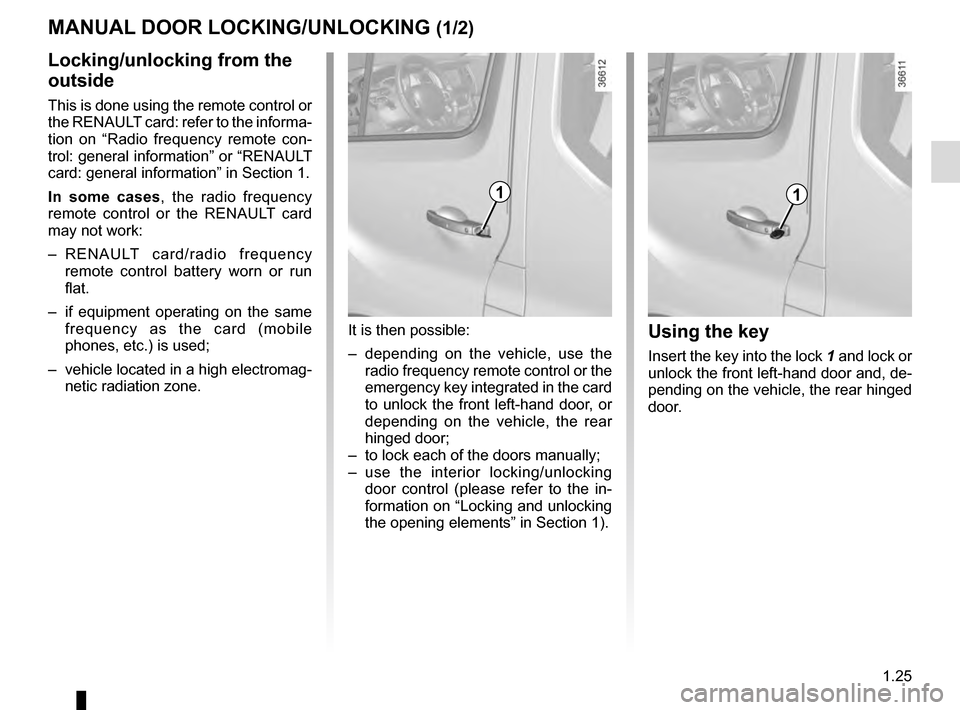
1.25
MANUAL DOOR LOCKING/UNLOCKING (1/2)
Using the key
Insert the key into the lock 1 and lock or
unlock the front left-hand door and, de-
pending on the vehicle, the rear hinged
door.
Locking/unlocking from the
outside
This is done using the remote control or
the RENAULT card: refer to the informa-
tion on “Radio frequency remote con-
trol: general information” or “RENAULT
card: general information” in Section 1.
In some cases, the radio frequency
remote control or the RENAULT card
may not work:
– RENAULT card/radio frequency remote control battery worn or run
flat.
– if equipment operating on the same frequency as the card (mobile
phones, etc.) is used;
– vehicle located in a high electromag- netic radiation zone.
1
It is then possible:
– depending on the vehicle, use the radio frequency remote control or the
emergency key integrated in the card
to unlock the front left-hand door, or
depending on the vehicle, the rear
hinged door;
– to lock each of the doors manually;
– use the interior locking/unlocking door control (please refer to the in-
formation on “Locking and unlocking
the opening elements” in Section 1).
1
Page 32 of 292
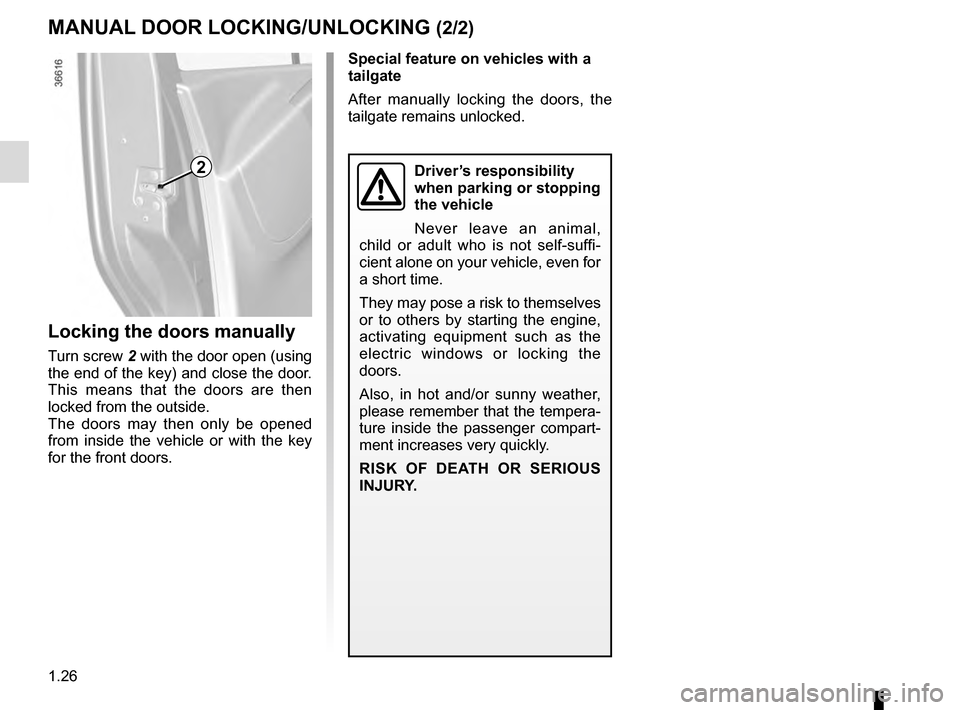
1.26
MANUAL DOOR LOCKING/UNLOCKING (2/2)
2
Locking the doors manually
Turn screw 2 with the door open (using
the end of the key) and close the door.
This means that the doors are then
locked from the outside.
The doors may then only be opened
from inside the vehicle or with the key
for the front doors.
Special feature on vehicles with a
tailgate
After manually locking the doors, the
tailgate remains unlocked.
Driver’s responsibility
when parking or stopping
the vehicle
Never leave an animal,
child or adult who is not self-suffi-
cient alone on your vehicle, even for
a short time.
They may pose a risk to themselves
or to others by starting the engine,
activating equipment such as the
electric windows or locking the
doors.
Also, in hot and/or sunny weather,
please remember that the tempera-
ture inside the passenger compart-
ment increases very quickly.
RISK OF DEATH OR SERIOUS
INJURY.
Page 33 of 292
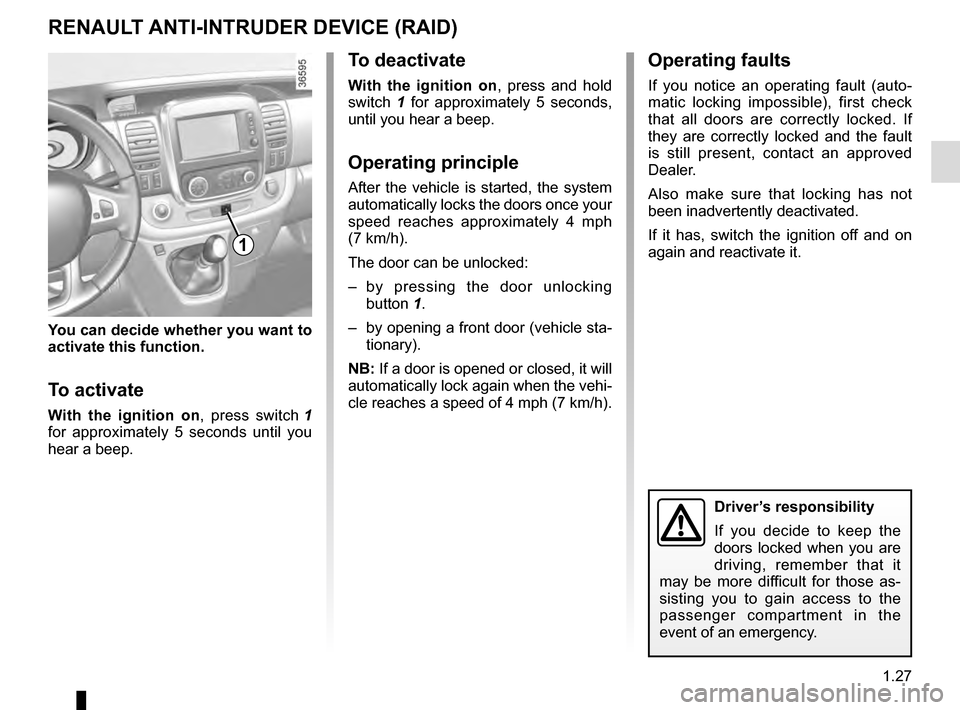
1.27
RENAULT ANTI-INTRUDER DEVICE (RAID)
Driver’s responsibility
If you decide to keep the
doors locked when you are
driving, remember that it
may be more difficult for those as-
sisting you to gain access to the
passenger compartment in the
event of an emergency.
You can decide whether you want to
activate this function.
To activate
With the ignition on , press switch 1
for approximately 5 seconds until you
hear a beep.
To deactivate
With the ignition on , press and hold
switch 1 for approximately 5 seconds,
until you hear a beep.
Operating principle
After the vehicle is started, the system
automatically locks the doors once your
speed reaches approximately 4 mph
(7 km/h).
The door can be unlocked:
– by pressing the door unlocking button 1.
– by opening a front door (vehicle sta- tionary).
NB: If a door is opened or closed, it will
automatically lock again when the vehi-
cle reaches a speed of 4 mph (7 km/h).
Operating faults
If you notice an operating fault (auto-
matic locking impossible), first check
that all doors are correctly locked. If
they are correctly locked and the fault
is still present, contact an approved
Dealer.
Also make sure that locking has not
been inadvertently deactivated.
If it has, switch the ignition off and on
again and reactivate it.
1
Page 34 of 292
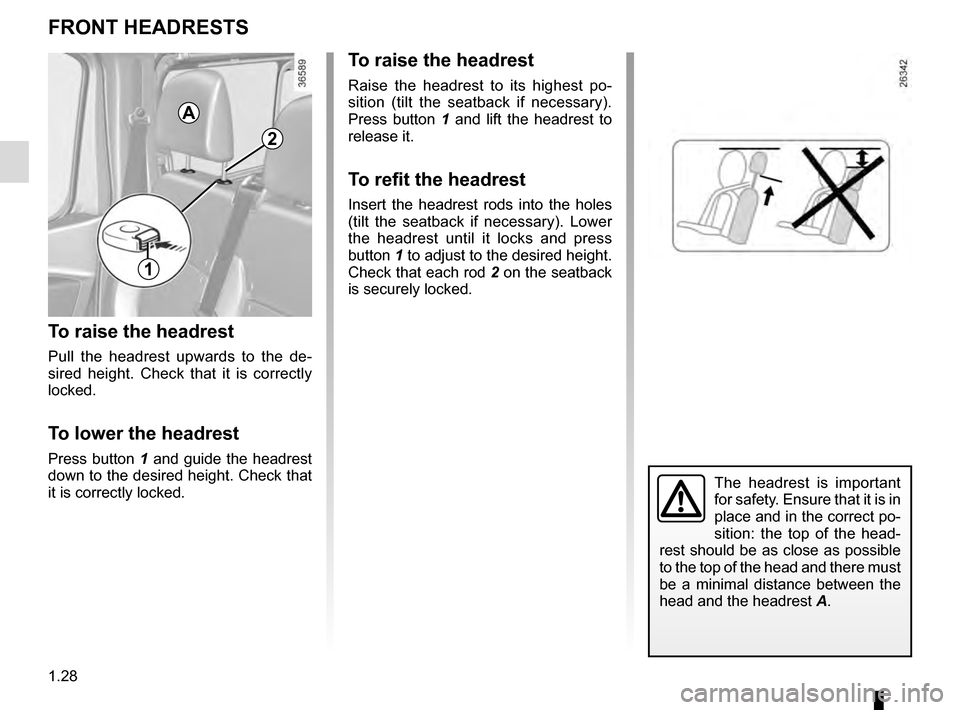
1.28
FRONT HEADRESTS
To raise the headrest
Pull the headrest upwards to the de-
sired height. Check that it is correctly
locked.
To lower the headrest
Press button 1 and guide the headrest
down to the desired height. Check that
it is correctly locked.
A
1
To raise the headrest
Raise the headrest to its highest po-
sition (tilt the seatback if necessary).
Press button 1 and lift the headrest to
release it.
To refit the headrest
Insert the headrest rods into the holes
(tilt the seatback if necessary). Lower
the headrest until it locks and press
button 1 to adjust to the desired height.
Check that each rod 2 on the seatback
is securely locked.
The headrest is important
for safety. Ensure that it is in
place and in the correct po-
sition: the top of the head-
rest should be as close as possible
to the top of the head and there must
be a minimal distance between the
head and the headrest A.
2
Page 35 of 292
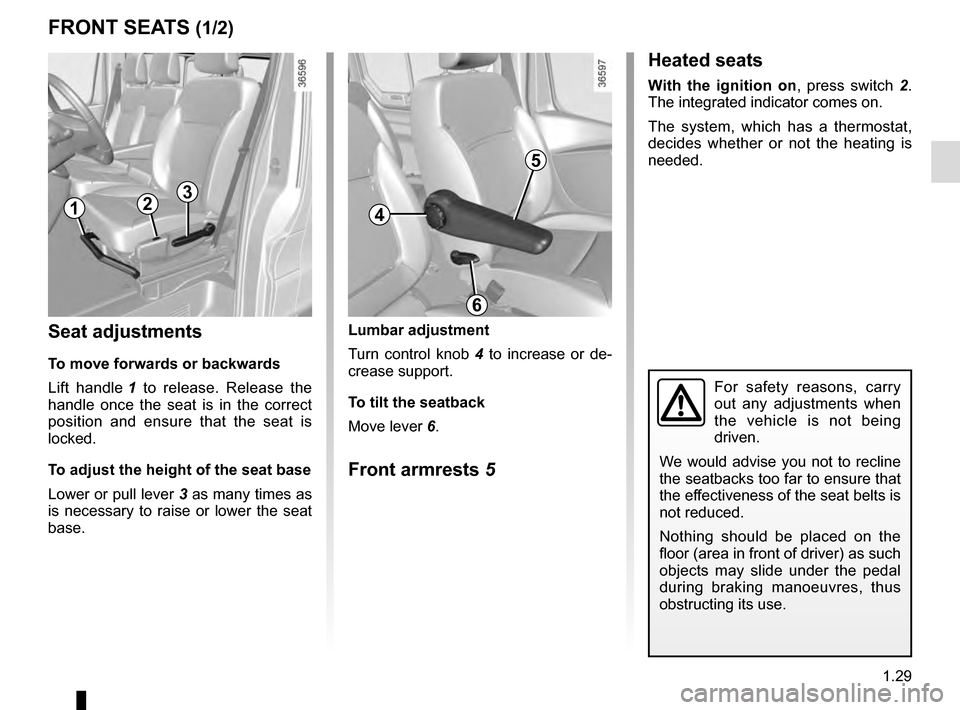
1.29
FRONT SEATS (1/2)
Lumbar adjustment
Turn control knob 4 to increase or de-
crease support.
To tilt the seatback
Move lever 6.
Front armrests 5
Seat adjustments
To move forwards or backwards
Lift handle 1 to release. Release the
handle once the seat is in the correct
position and ensure that the seat is
locked.
To adjust the height of the seat base
Lower or pull lever 3 as many times as
is necessary to raise or lower the seat
base.
13
For safety reasons, carry
out any adjustments when
the vehicle is not being
driven.
We would advise you not to recline
the seatbacks too far to ensure that
the effectiveness of the seat belts is
not reduced.
Nothing should be placed on the
floor (area in front of driver) as such
objects may slide under the pedal
during braking manoeuvres, thus
obstructing its use.
Heated seats
With the ignition on , press switch 2.
The integrated indicator comes on.
The system, which has a thermostat,
decides whether or not the heating is
needed.
24
6
5
Page 36 of 292
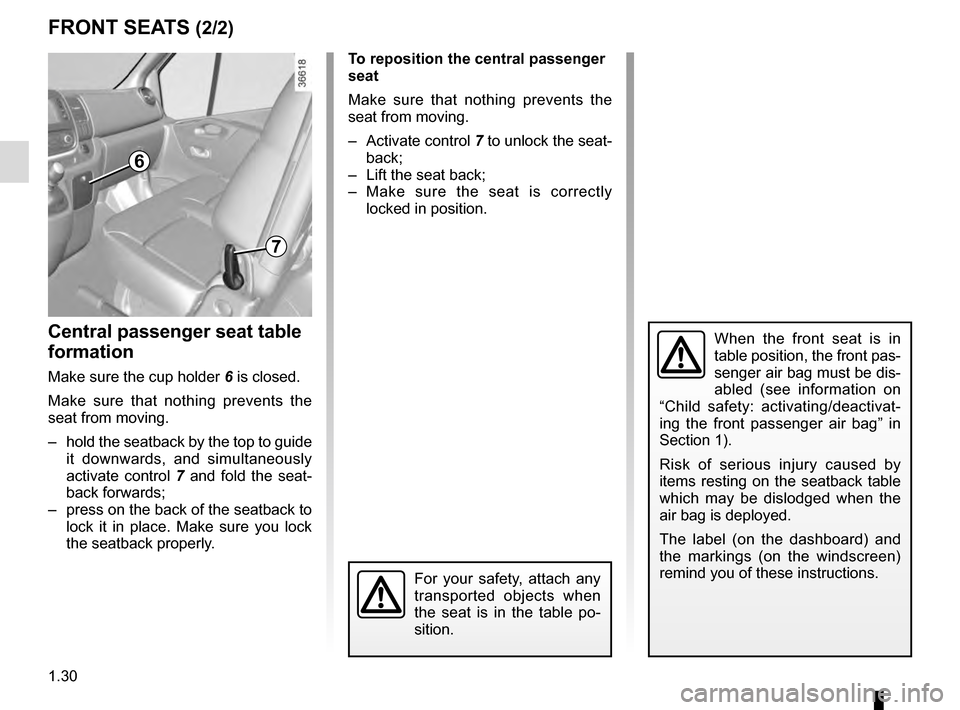
1.30
FRONT SEATS (2/2)
Central passenger seat table
formation
Make sure the cup holder 6 is closed.
Make sure that nothing prevents the
seat from moving.
– hold the seatback by the top to guide it downwards, and simultaneously
activate control 7 and fold the seat-
back forwards;
– press on the back of the seatback to lock it in place. Make sure you lock
the seatback properly.
7
To reposition the central passenger
seat
Make sure that nothing prevents the
seat from moving.
– Activate control 7 to unlock the seat-
back;
– Lift the seat back;
– Make sure the seat is correctly locked in position.
For your safety, attach any
transported objects when
the seat is in the table po-
sition.
When the front seat is in
table position, the front pas-
senger air bag must be dis-
abled (see information on
“Child safety: activating/deactivat-
ing the front passenger air bag” in
Section 1).
Risk of serious injury caused by
items resting on the seatback table
which may be dislodged when the
air bag is deployed.
The label (on the dashboard) and
the markings (on the windscreen)
remind you of these instructions.
6
Page 37 of 292
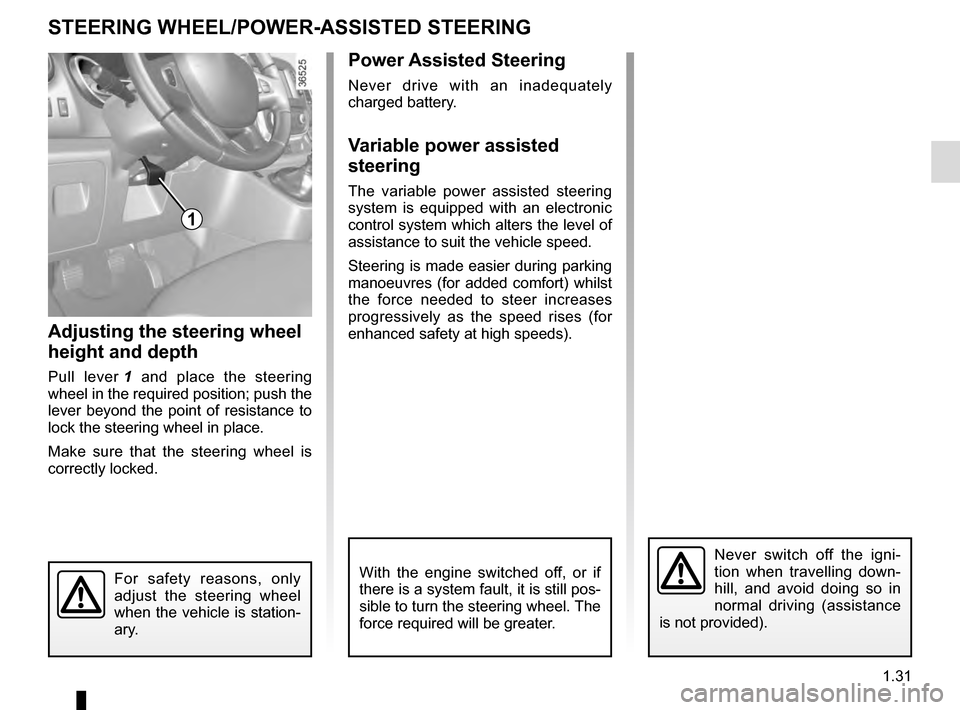
1.31
Power Assisted Steering
Never drive with an inadequately
charged battery.
Variable power assisted
steering
The variable power assisted steering
system is equipped with an electronic
control system which alters the level of
assistance to suit the vehicle speed.
Steering is made easier during parking
manoeuvres (for added comfort) whilst
the force needed to steer increases
progressively as the speed rises (for
enhanced safety at high speeds).
Adjusting the steering wheel
height and depth
Pull lever 1 and place the steering
wheel in the required position; push the
lever beyond the point of resistance to
lock the steering wheel in place.
Make sure that the steering wheel is
correctly locked.
For safety reasons, only
adjust the steering wheel
when the vehicle is station-
ary.
STEERING WHEEL/POWER-ASSISTED STEERING
1
Never switch off the igni-
tion when travelling down-
hill, and avoid doing so in
normal driving (assistance
is not provided).
With the engine switched off, or if
there is a system fault, it is still pos-
sible to turn the steering wheel. The
force required will be greater.
Page 38 of 292
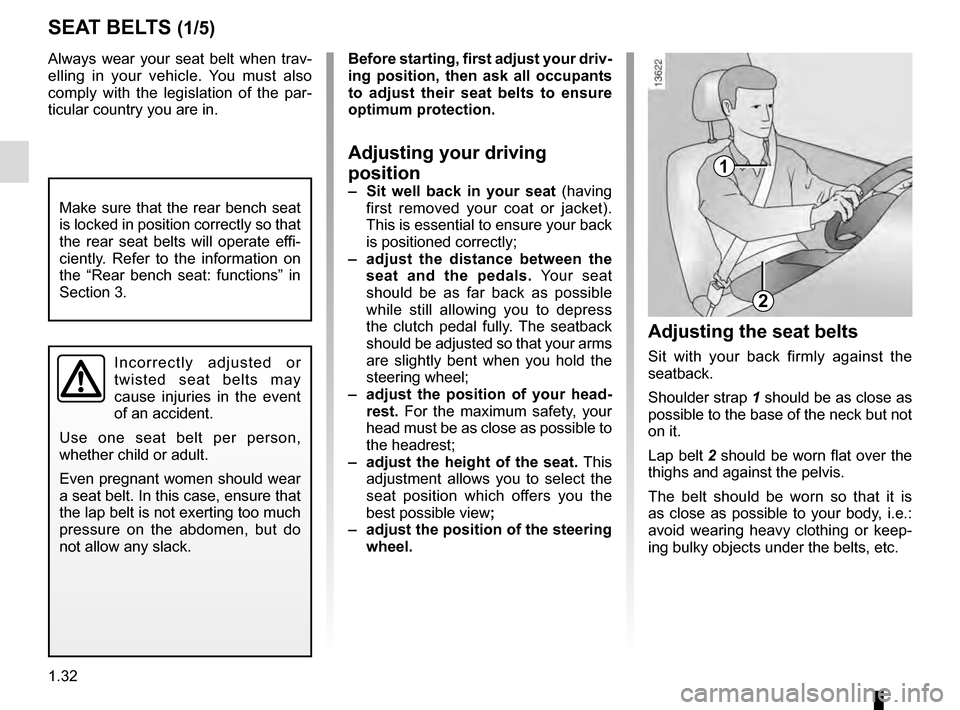
1.32
Always wear your seat belt when trav-
elling in your vehicle. You must also
comply with the legislation of the par-
ticular country you are in.
SEAT BELTS (1/5)
1
2
Incorrectly adjusted or
twisted seat belts may
cause injuries in the event
of an accident.
Use one seat belt per person,
whether child or adult.
Even pregnant women should wear
a seat belt. In this case, ensure that
the lap belt is not exerting too much
pressure on the abdomen, but do
not allow any slack.
Before starting, first adjust your driv-
ing position, then ask all occupants
to adjust their seat belts to ensure
optimum protection.
Adjusting your driving
position
– Sit well back in your seat (having
first removed your coat or jacket).
This is essential to ensure your back
is positioned correctly;
– adjust the distance between the seat and the pedals. Your seat
should be as far back as possible
while still allowing you to depress
the clutch pedal fully. The seatback
should be adjusted so that your arms
are slightly bent when you hold the
steering wheel;
– adjust the position of your head- rest. For the maximum safety, your
head must be as close as possible to
the headrest;
– adjust the height of the seat. This
adjustment allows you to select the
seat position which offers you the
best possible view ;
– adjust the position of the steering
wheel.
Adjusting the seat belts
Sit with your back firmly against the
seatback.
Shoulder strap 1 should be as close as
possible to the base of the neck but not
on it.
Lap belt 2 should be worn flat over the
thighs and against the pelvis.
The belt should be worn so that it is
as close as possible to your body, i.e.:
avoid wearing heavy clothing or keep-
ing bulky objects under the belts, etc.
Make sure that the rear bench seat
is locked in position correctly so that
the rear seat belts will operate effi-
ciently. Refer to the information on
the “Rear bench seat: functions” in
Section 3.
Page 39 of 292
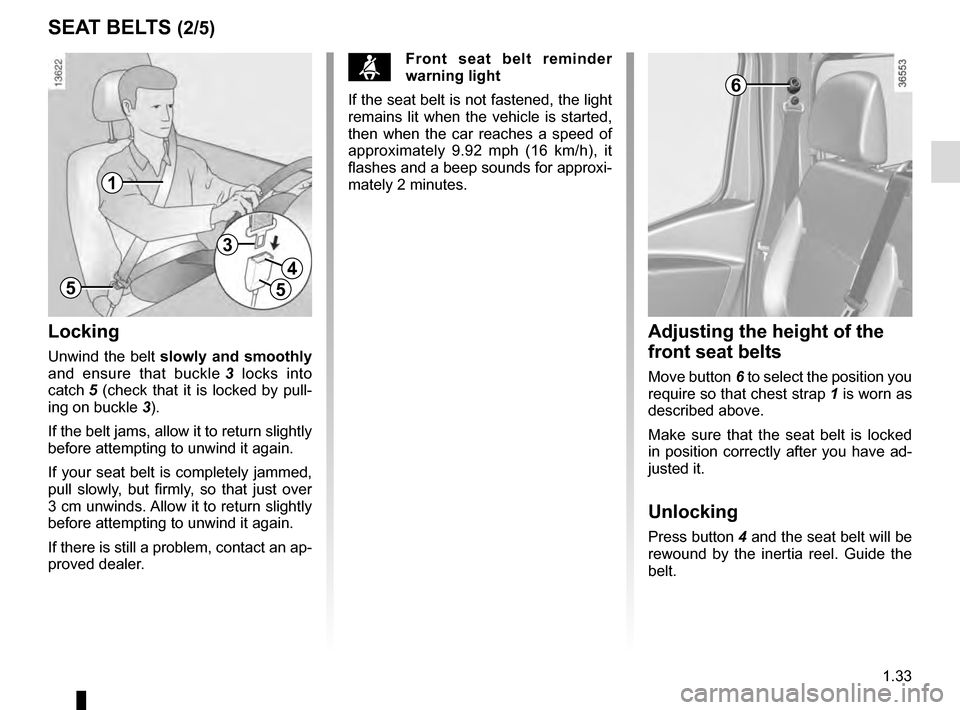
1.33
SEAT BELTS (2/5)
ßFront seat belt reminder
warning light
If the seat belt is not fastened, the light
remains lit when the vehicle is started,
then when the car reaches a speed of
approximately 9.92 mph (16 km/h), it
flashes and a beep sounds for approxi-
mately 2 minutes.
Adjusting the height of the
front seat belts
Move button 6 to select the position you
require so that chest strap 1 is worn as
described above.
Make sure that the seat belt is locked
in position correctly after you have ad-
justed it.
Unlocking
Press button 4 and the seat belt will be
rewound by the inertia reel. Guide the
belt.
6
Locking
Unwind the belt slowly and smoothly
and ensure that buckle 3 locks into
catch 5 (check that it is locked by pull-
ing on buckle 3).
If the belt jams, allow it to return slightly
before attempting to unwind it again.
If your seat belt is completely jammed,
pull slowly, but firmly, so that just over
3 cm unwinds. Allow it to return slightly
before attempting to unwind it again.
If there is still a problem, contact an ap-
proved dealer.
1
5
3
4
5
Page 40 of 292
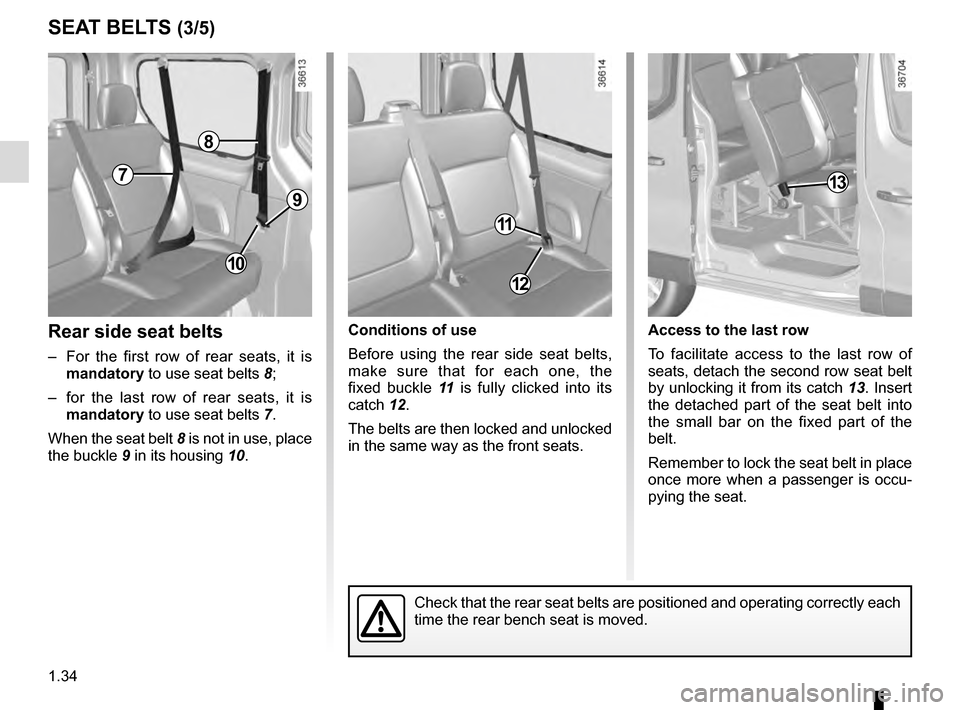
1.34
SEAT BELTS (3/5)
Rear side seat belts
– For the first row of rear seats, it is mandatory to use seat belts 8;
– for the last row of rear seats, it is mandatory to use seat belts 7.
When the seat belt 8 is not in use, place
the buckle 9 in its housing 10.
Conditions of use
Before using the rear side seat belts,
make sure that for each one, the
fixed buckle 11 is fully clicked into its
catch 12.
The belts are then locked and unlocked
in the same way as the front seats. Access to the last row
To facilitate access to the last row of
seats, detach the second row seat belt
by unlocking it from its catch
13. Insert
the detached part of the seat belt into
the small bar on the fixed part of the
belt.
Remember to lock the seat belt in place
once more when a passenger is occu-
pying the seat.
8
7
11
12
Check that the rear seat belts are positioned and operating correctly ea\
ch
time the rear bench seat is moved.
10
9
13